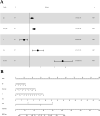Recognition of refractory Mycoplasma pneumoniae pneumonia among Myocoplasma pneumoniae pneumonia in hospitalized children: development and validation of a predictive nomogram model
- PMID: 37817172
- PMCID: PMC10566172
- DOI: 10.1186/s12890-023-02684-1
Recognition of refractory Mycoplasma pneumoniae pneumonia among Myocoplasma pneumoniae pneumonia in hospitalized children: development and validation of a predictive nomogram model
Abstract
Backgroud: The current diagnostic criteria for refractory Mycoplasma pneumoniae pneumonia (RMPP) among Mycoplasma pneumoniae Pneumonia (MPP) are insufficient for early identification, and potentially delayed appropriate treatment. This study aimed to develop an effective individualized diagnostic prediction nomogram for pediatric RMPP.
Methods: A total of 517 hospitalized children with MPP, including 131 with RMPP and 386 without RMPP (non-RMPP), treated at Lianyungang Maternal and Child Health Care Hospital from January 2018 to December 2021 were retrospectively enrolled as a development (modeling) cohort to construct an RMPP prediction nomogram. Additionally, 322 pediatric patients with MPP (64 with RMPP and 258 with non-RMPP, who were treated at the Affiliated Hospital of Xuzhou Medical University from June 2020 to May 2022 were retrospectively enrolled as a validation cohort to assess the prediction accuracy of model. Univariable and multivariable logistic regression analyses were used to identify RMPP risk factors among patients with MPP. Nomogram were generated based on these risk factors using the rms package of R, and the predictive performance was evaluated based on receiver operating characteristic (ROC) curves and using decision curve analysis (DCA).
Results: Multivariate analysis revealed five significant independent predictors of RMPP among patients with MPP: age (hazard ratio [HR] 1.16, 95% confidence interval [CI] 1.08-1.33, P = 0.038), fever duration (HR 1.34, 95%CI 1.20-1.50, P < 0.001), lymphocyte count (HR 0.45, 95%CI 0.23-0.89, P = 0.021), serum D-dimer (D-d) level (HR 1.70, 95%CI 1.16-2.49, P = 0.006), and pulmonary imaging score (HR 5.16, 95%CI 2.38-11.21, P < 0.001). The area under the ROC curve was 90.7% for the development cohort and 96.36% for the validation cohort. The internal and external verification calibration curves were almost linear with slopes of 1, and the DCA curve revealed a net benefit with the final predictive nomogram.
Conclusion: This study proposes a predictive nomogram only based on five variables. The nomogram can be used for early identification of RMPP among pediatric patients with MPP, thereby facilitating more timely and effective intervention.
Keywords: Calibration curve; Decision curve analysis; Nomogram; Receiver operating characteristic curve; Refractory Mycoplasma pneumoniae pneumonia.
© 2023. BioMed Central Ltd., part of Springer Nature.
Conflict of interest statement
The authors declare no competing interests.
Figures




References
-
- Liu JH, Liu JR, Tang XL, et al. Predictive factors for sequelae of bronchitis obliterans in refractory Mycoplasma pneumoniae pneumonia. Zhonghua Er Ke Za Zhi. 2023;61(4):317–321. - PubMed
-
- Pediatrics of Chinese Medical Association Branch of the Breathing Group. Chinese Journal of Applied Clinical Pediatrics Editorial Board Expert consensus on diagnosis and treatment of mycoplasma pneumoniae pneumonia in children (2015) Chin J Appl Clin Pediatr. 2015;30(17):1304–1308.
MeSH terms
Substances
Grants and funding
LinkOut - more resources
Full Text Sources

